Sorry, nothing in cart.
Steatite of Meleto quarry
- 4260 Views
- |
The “Scaly-Clays Complex” is the prevailing rock formation in the section of the Appennines between Emilia and Tuscany, but many different kinds of alloctonous rocks may be observed there; ophiolites are frequent and, among them, the so-ca/led “Green Rocks” (gabbros, diabases, serpentinites). They are chaotically and accidentally embedded in the clastic sedimentary clays; probably originated by intensive submarine volcanic activity between Corsica and Tuscany, they were fragmented and moved along the Appennines by orogeny between Cretaceous and Pliocene. Ophiolitic outcroppings are well known in Tuscany in the Rognosi Mts, Val di Cecina, Livornesi Mts, Serchio Valley and in the area of Monte Ferrato/Impruneta near Florence . The Meleto quarry (also said Palagio quarry), where the special clay far the famous “Cotto Fiorentino” floor-tiles is exploited, is located near Impruneta; grey-green hydrothermalites (serpentinites, carbonates, quartz) outcrop there, frequently crossed by calcite veins with interesting mineralizations including Ni-minerals.
MINERALS
Most of the minerals found in the quarry occur as well cristallized micro specimens so they are hereafter described with reference to their matrix rocks; it is impossible to locate the various occurrences within the quarry, due to continuous and active exploiting.
MINERALS IN SERPENTINITES.
Talc (“Steatite “): Within the rare masses of serpentine there are calcite veins inside which there are aesthetic aggregate mammillary of steatite. Perhaps the most aesthetic specimens at European level. As out standing , bright-green specimens. It occurs as either mammillary or globular aggregates to even 2 cm in diameter, grouped to cover large surfaces. Usually fluorescent in yellow.
MINERALS IN CARBONATIC VEINS AND HYDROTHERMALITES.
- Calcite: in cavities as beautiful rhombohedral , milky to clear xls to 6 mm, in para/lei growths.
- Celestite: as tabular single xls to some mm, pale sky-blue, transparent to translucent.
- Dolomite: as cream-white micro rhombohedrons.
- Goethite: as micro dull -black octahedrons, pseudo after pyrite .
- Hematite: as lustrous micro blades, sometimes grouped in rosettes.
- Jamborite: as either pseudos after millerite or as pale-green crusts and masses; with millerite and black micro octahedrons ( vaesite?).
- Marcasite: as micro globular, blackish aggregates.
- Millerite: as nice brass-yellow needles to 5 mm, grouped as either stars or sprays or urchins; with pyrite, jamborite, vaesite (?).
- Pyrite, as micro xls of many different forms.
- Quartz, as prismatic, some times lattened, milky-white to clear xls; also in parallel growths . Often supporting other minerals.
- Sphalerite: as micro tetrahedrons, honey -yellow to yellowish orange.
- Vaesite (?): lustrous black micro octahedrons have been tentatively identified as vaesite due to sharp cleavage surfaces and close association with millerite and jamborite.
- Sky-blue unknown: as felts of micro needles.
- Orange-red unknown (reevesite?): as micro prisms .
MINERALS IN HYDROTHERMALITES.
- Anatase: as micro tabular, honey-yellow xls.
- Barite: as white tabular xls to l cm in rare cavities.
- Hematite: as metallic grains.
- Quartz: as bipyramidal, compenetrated xls, embedded in rock .
MINERALS IN SCALY CLAYS.
- Barite: as short tabular, colorless to pale-blue xls to l cm.
- Calcite: as short prismatic, lenticular or scalenohedral xls to 3 cm; colorless to white, sometimes as nice, complex specimens.
- Chacopyrite: found only once as crude tetrahedrons.
- Celestite: rare in this association. One beautiful blue xl reported from the early works.
- Fluorite: rare, as micro colorless xls.
- Pyrolusite: as dendrites an calcite.
- Pyrrhotite: as thin tabular, hexagonal xls to 8 mm; rarely as rosettes.


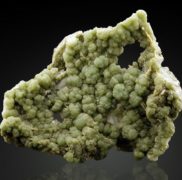
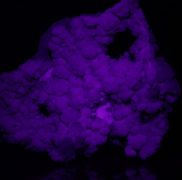
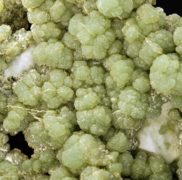
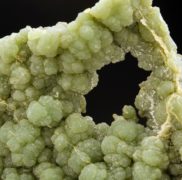
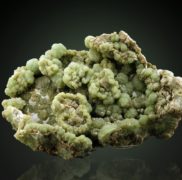
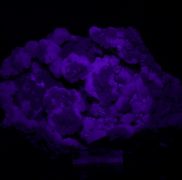
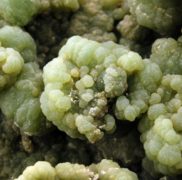
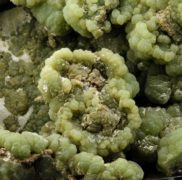
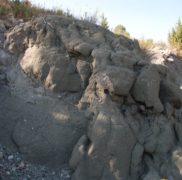

Leave a Reply